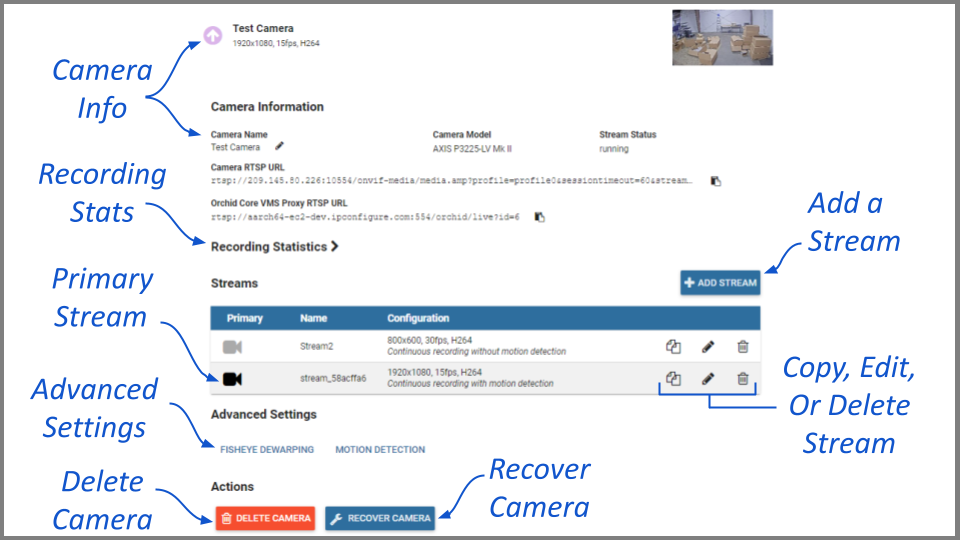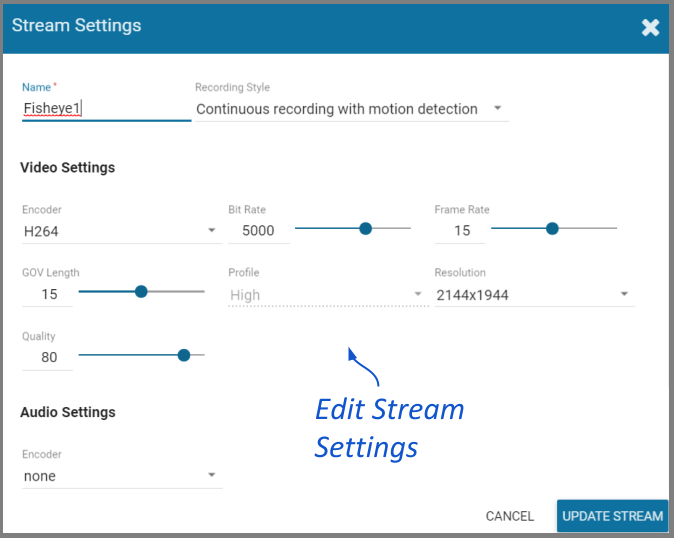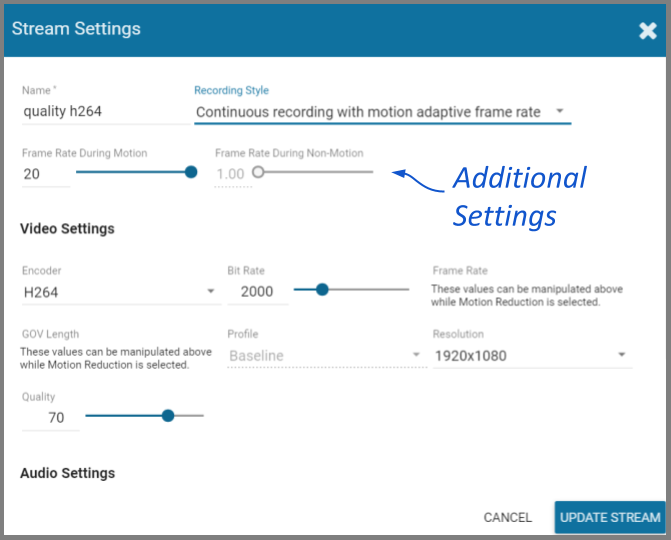| |
This is the Edit pencil icon. |
| |
This is the Expand icon (used to view the list of Recording Statistics). |
| |
This is the Condense icon (used to close the list of Recording Statistics). |
| |
This is the Camera icon. (Black represents the Primary Stream. Gray represents an available camera stream.) |
After a camera has been added to Orchid Core VMS, settings such as the stream resolution and frame rate can be updated through the camera stream’s configuration. While this is true for most cameras, cameras added using the RTSP driver (old cameras and cameras that don’t support ONVIF) cannot be edited through Orchid Core VMS. You will need to access those cameras directly to edit settings. (Refer to the camera manufacturer’s documentation for more details.)
- From the list of registered cameras on the Camera Configuration screen, click the name of the camera you want to edit. (The list will expand to display all of the information for the selected camera. This includes the camera name, IP address, and all of the available streams.)

Camera Information
- To change the camera name, click the Edit pencil to the right of the camera name. Enter a new name in the Camera Name field and press the Update Camera button. (Remember: The cameras are listed in alphabetical order by camera name.)
This screen also displays the camera model and the status of the camera stream in use. These settings are informational and cannot be altered here; please refer to the System Status section for status descriptions.
The RTSP URL status fields are typically used for troubleshooting. These allow for a comparison of the video coming from the camera and the video as received by Orchid Core VMS to determine where a problem might be occurring.
- The Camera RTSP URL (which contains the camera’s IP address) represents the video stream that Orchid Core VMS is recording.
- The Orchid Proxy RTSP URL represents the video that Orchid Core VMS is showing on the Stage. (For more details, please refer to the Advanced Topics section.)
Recording Statistics
- Click the Expand icon to open the Recording Statistics section. This section will show the statistics that indicate how the recording stream is performing.

The top section provides the average packet loss percentage over periods of the last 1 minute, 5 minutes, and 15 minutes. It’s important to be aware if packet loss is occurring because it may impact the quality of archived video. These averages are updated about every 5 seconds and will mostly be used for troubleshooting. For more information on analyzing the packet loss percentages, please refer to the section on Checking for Packet Loss.)
The top section also displays the average bitrates over the same periods of time. These indicate how much video data is being transferred, per second, from the camera to the Orchid Core VMS server. You may notice that the average bitrates provided here do not match the bitrates that have been configured under Stream settings. This is not unusual and should not cause concern. These bitrate values reflect the reality of your system, and can be used as a reference in making adjustments to the configured bitrate.
The Recording Statistics feature also provides information about the last video file that has been written to the system for this camera stream. This statistic is updated about once per minute. If the camera is configured to record continuously, and the last video file is more than 1 minute old, the system may not be recording this camera stream.
- Click the Condense icon to close the list of Recording Statistics.
Streams
A camera stream is a profile with all of the basic settings used by Orchid Core VMS to record video from the camera. The stream currently being used by Orchid Core VMS, the primary stream, is indicated by a darkened camera icon.
- To select a new stream, click the Camera icon located to the left of the name of the stream you want Orchid Core VMS to record with.
- To edit a stream, click the Edit pencil icon (located to the right of the stream name). A screen will appear with all of the stream settings available for editing.

- Review or change the stream name so users can easily identify the camera stream.
- Review or change the Recording Style for the camera stream.
Orchid Core VMS offers five different recording styles. Refer to the descriptions below (and the table that follows) before making your selection.
- Continuous Recording with Motion Detection: Orchid Core VMS will continuously record video from the camera and perform motion detection. This is the default and recommended setting.
- Continuous Recording without Motion Detection: Orchid Core VMS will continuously record video from the camera, but will not perform motion detection. This option offers a modest reduction in CPU load on the Orchid Core VMS server.
- Continuous Recording with Motion Adaptive Frame Rate: Orchid Core VMS will record at a higher frame rate while motion is detected, and a different (slower) frame rate while no motion is detected. These frame rates are user-selectable (as shown in the screenshot following the table). (Due to the way H264 compresses video, this recording style typically shows significant savings in disk usage only for inexpensive cameras with noisy sensors, or cameras in low-light environments.)
- Proxy Only: Orchid Core VMS will provide live video from the camera but will not record video.
- Recording Only When Motion Detected: Orchid Core VMS will only record video from the camera when motion is detected. This may result in a reduction in disk usage on the Orchid Core VMS server, however, motion detection accuracy may vary and result in video loss.
| Continuous recording with motion detection (Default) | Continuous recording without motion detection | Continuous recording with motion adaptive frame rate | Proxy only, no video will be recorded | Recording only when motion is detected | |
|---|---|---|---|---|---|
| Recording and playback are available | Yes | Yes | Yes | No | Yes (When motion is detected) |
| Live view is available in low-bandwidth mode | Yes | No | Yes | No | Yes |
| Thumbnail previews are available | Yes | Yes | Yes | No | Yes |
If you select the Continuous recording with motion adaptive frame rate recording style, you will need to set both the Frame Rate During Motion and the Frame Rate During Non-Motion. (The Frame Rate During Motion will dictate the available settings for the Frame Rate During Non-Motion. Allowable settings for the Frame Rate During Non-Motion range from 1 up to a setting that is less than or equal to the Frame Rate During Motion.)

- Continue to review and change camera stream settings for video, audio and bandwidth as needed. Refer to the definitions below for help in selecting settings.
Video Settings
Each camera type reports its own default values provided by the camera manufacturer. Use those default values unless otherwise noted.
- Encoder: The type of compression used for the camera’s video. In WebRTC mode, Orchid Core VMS only supports H264 video. In Low-bandwidth mode, Orchid Core VMS supports JPEG, MPEG4, and H264 (recommended). (Available selections depend on the camera.)
- Bit Rate: The target data size (in kilobits per second) of the compressed video. Increasing this value will typically improve image quality at the expense of increased disk usage and reduced retention. In WebRTC mode, bitrates of 2000 kbps or less tend to work best. The default value is recommended.
- Frame Rate: The number of frames per second transmitted within the video stream. Most Orchid Core VMS users are best served by values between 7 and 12. Higher frame rates provide more video detail at the expense of reduced video retention and increased bandwidth usage.
- GOV Length: When using H264 compression, this value specifies how often the camera sends a full image frame (instead of a “change frame” which only describes differences between frames). For example, if this is set to 15, Orchid Core VMS will send a full image frame once every 15 frames. Be aware of how this setting may impact video quality. As the GOV length decreases, the system will need to send more keyframes of video (within the set bit rate). This may result in a loss of quality for those keyframes. The default value is recommended.
- Profile: When using H264 compression, this specifies an H264 Profile of either Baseline, Main, or High. Higher profiles offer better compression (which means increased retention and lower bandwidth usage) at the expense of increased CPU utilization when decoding video. The highest available profile is recommended.
- Resolution: The resolution of video transmitted by the camera. Higher values increase video detail at the expense of reduced video retention and increased bandwidth usage. Most Orchid Core VMS users are best served by resolutions between 1280×720 and 1920×1080.
- Quality: This value affects how much the video is compressed. Higher values increase video quality at the expense of increased storage requirements (and thus reduced video retention). The default value is recommended.
Audio Settings (if supported)
Beginning in Orchid Core VMS version 2.8, audio control is no longer supported at the Player/Stage level. However, the Orchid Core VMS server is still recording audio for those cameras that support it, and this audio will be available in exported video files. Future versions of Orchid Core VMS will support audio over WebRTC.
These Audio Settings will appear on the screen only if the camera supports audio and will determine how the Orchid server records the audio. Each camera type reports its own default settings. Use those default values unless otherwise noted.
- Encoder: The type of compression used by the camera’s audio. Orchid Core VMS supports “None” (audio is disabled), G711, and AAC (recommended if audio is desired).
- Bit Rate: The target data size (in kilobits per second) of the compressed audio. The default value is recommended.
- Sample Rate: Affects the quality of recorded sound. The default value is recommended.
Low-bandwidth Settings
- Decode all frames: This setting applies to viewing Live video in Low-bandwidth mode. When Decode all frames is disabled, Orchid Core VMS will display only full frames (per the configured GOV length) when viewing live video in Low-bandwidth mode. When Decode all frames is enabled, Orchid Core VMS will display every available frame from the camera (regardless of GOV length) when viewing live video in Low-bandwidth mode, assuming sufficient bandwidth exists. Decode all frames is disabled by default because enabling this setting will increase CPU use on your Orchid Core VMS server. (For more details on Low-bandwidth mode, please refer to the Advanced Topics section.)
- Once the stream settings have been updated, click the Update Stream button to save the new stream settings. It may take a few seconds for the settings to change based on the camera being updated.
- You may review the impact that the stream settings have on video playback for each camera. Simply click on the corresponding thumbnail to watch a current live video feed.


Post your comment on this topic.